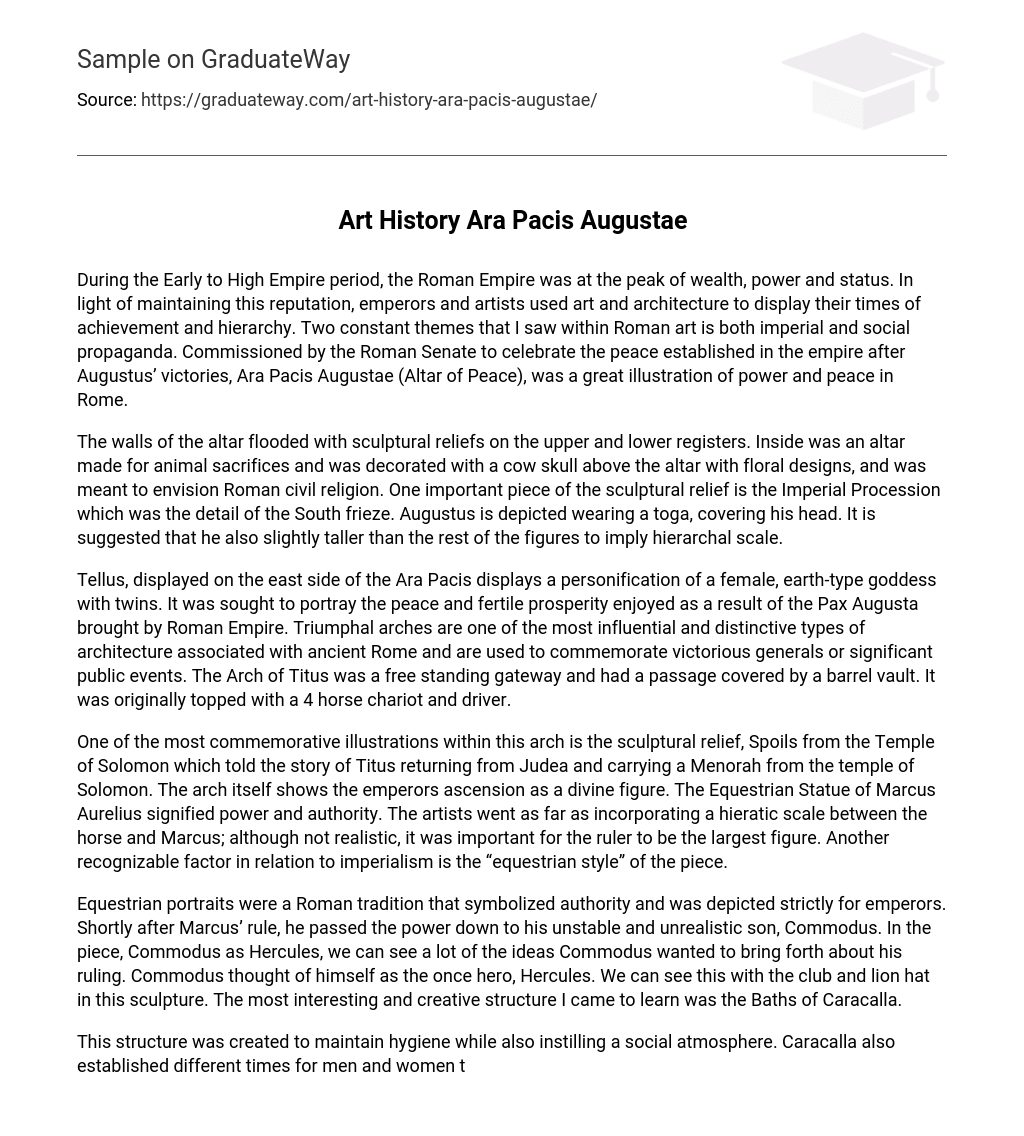During the Early to High Empire period, the Roman Empire reached its height in terms of wealth, power, and social standing. In order to maintain this reputation, emperors and artists utilized art and architecture as a means of showcasing their accomplishments and hierarchical position. One consistent aspect that stood out to me in Roman art was the presence of imperial and social propaganda. The Ara Pacis Augustae (Altar of Peace), commissioned by the Roman Senate to commemorate the establishment of peace in the empire following Augustus’ victories, exemplifies both power and tranquility in Rome.
The walls of the altar have sculptural reliefs on the upper and lower registers. Inside, there is an altar for animal sacrifices which is adorned with a cow skull above it along with floral designs. This altar is meant to represent Roman civil religion. One notable part of the sculptural relief is the Imperial Procession, found on the South frieze. In this detail, Augustus is depicted wearing a toga and covering his head. It can be inferred that he is slightly taller than the other figures, symbolizing his hierarchical scale.
Displayed on the east side of the Ara Pacis, Tellus depicts a female goddess with twins, symbolizing the peaceful and prosperous conditions brought about by the Pax Augusta of the Roman Empire. Triumphal arches were a prominent architectural feature of ancient Rome, serving to honor successful generals or important public events. The Arch of Titus, a standalone gateway, featured a barrel-vaulted passage and was originally crowned with a chariot pulled by four horses and a driver.
One of the most notable depictions in this arch is the sculptural relief known as Spoils from the Temple of Solomon. This artwork portrays Titus bringing back a Menorah from the temple of Solomon after his return from Judea. Moreover, the arch itself demonstrates the emperor’s rise as a divine figure. The Equestrian Statue of Marcus Aurelius signifies his power and authority. The artists even included a hieratic scale between the horse and Marcus, symbolizing the ruler’s significance. Additionally, the “equestrian style” of the piece is another element associated with imperialism.
Equestrian portraits were a tradition in ancient Rome that represented authority and were solely created for emperors. Following Marcus Aurelius’ reign, power was then transferred to his unstable and unrealistic son, Commodus. In the artwork titled “Commodus as Hercules,” we can observe many of the concepts Commodus wanted to convey about his rule. Commodus identified himself as the legendary hero, Hercules, which is evident by the presence of a club and a lion-skin hat in this sculpture. Among the fascinating and innovative structures I discovered, the Baths of Caracalla stood out the most.
This structure was designed to promote cleanliness and foster a sense of community. Caracalla also implemented separate timings for men and women to utilize this facility. In its original form, it consisted of bricks and concrete, covered in marble and mosaics. It included various amenities like a gym, swimming pool, hot baths, and cold baths, essentially resembling a contemporary spa. Additionally, the sculpture of the Tetrarchs stood out to me. This artwork possessed unique qualities that set it apart and exemplified Roman society and authority.
Created from rare purple stone, this piece of art deviates from the usual idealistic and humanistic styles of Roman art, opting for a more geometric approach. The figures are not individually distinguishable, emphasizing the concept of unity and shared power. At the time of its creation, Emperor Diocletian divided the empire into four parts, with two senior emperors and two junior emperors ruling The West and The East respectively. The artwork conveys a sense of vigilance and unity through the embracing poses of the figures.





